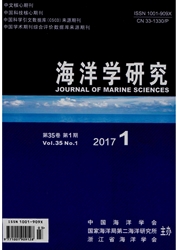

 中文摘要:
中文摘要:
本文基于反射地震数据和MODIS遥感数据,对南海东沙海域内孤立波及孤立波群的形态有了系统的认识。内孤立波存在上升型和下降型两种极性波,又根据波形分成"钟形"、"平底形"和"碗形"三种类型,孤立波在波谷处的形状与孤立波振幅有关。单个内孤立波在传播一段时间后,受到各种因素的影响,会发育成波群。东沙海域的不同位置存在两种波群:"有序型"波群和"复杂型"波群,结合它们的位置及波群传播过程,认为这两种波群可能是孤立波从深海向陆架的整个传播过程中的两个阶段,"有序型"波群在被东沙岛阻碍后,受到各种海底地形、东沙环礁、波-波相互作用的影响,转变成"复杂型"波群。
 英文摘要:
英文摘要:
Based on multi-channel seismic profiles and MODIS images,the form of internal solitary wave(ISW)packets in Dongsha area of the South China Sea was studied.There are two polar waves:elevation and depression wave,and internal solitary waves can be divided into"bell shape","flat shape"and"bowl shape"according to the waveforms.The shape of wave trough is associated with amplitude.Influenced by various factors,the solitions will develop into packets within the propagation process.Two typical wave packets are observed at different locations in Dongsha area:rank-ordered ISW packet and more complex ISW packet,and combined with their locations and propagation,they are considered to be two stages of the propagation process from deep sea to shelf.A rank-ordered wave packet is influenced by submarine topography,Dongsha Reef and wave-wave interaction after Dongsha Island,then turns into a more complex wave packet.
 同期刊论文项目
同期刊论文项目
 同项目期刊论文
同项目期刊论文
 期刊信息
期刊信息
